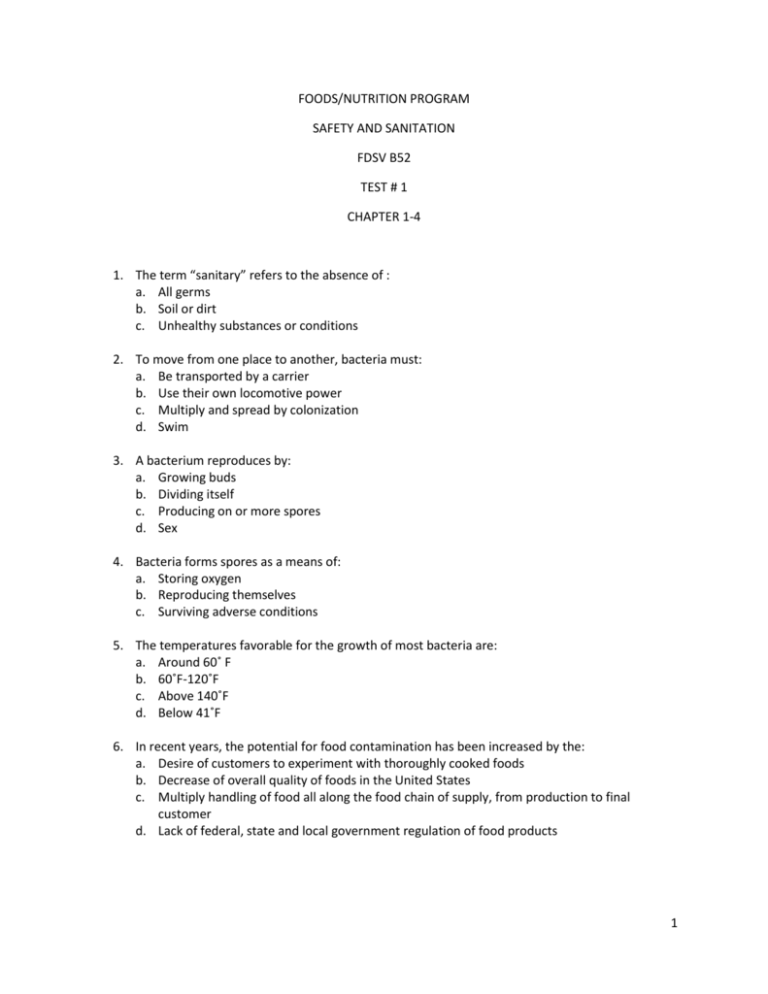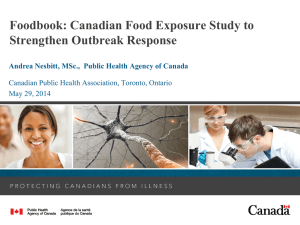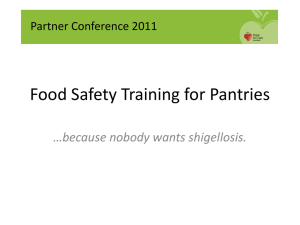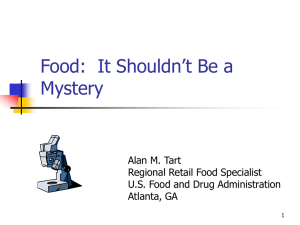Test 1 - Bakersfield College
advertisement

FOODS/NUTRITION PROGRAM SAFETY AND SANITATION FDSV B52 TEST # 1 CHAPTER 1-4 1. The term “sanitary” refers to the absence of : a. All germs b. Soil or dirt c. Unhealthy substances or conditions 2. To move from one place to another, bacteria must: a. Be transported by a carrier b. Use their own locomotive power c. Multiply and spread by colonization d. Swim 3. A bacterium reproduces by: a. Growing buds b. Dividing itself c. Producing on or more spores d. Sex 4. Bacteria forms spores as a means of: a. Storing oxygen b. Reproducing themselves c. Surviving adverse conditions 5. The temperatures favorable for the growth of most bacteria are: a. Around 60˚ F b. 60˚F-120˚F c. Above 140˚F d. Below 41˚F 6. In recent years, the potential for food contamination has been increased by the: a. Desire of customers to experiment with thoroughly cooked foods b. Decrease of overall quality of foods in the United States c. Multiply handling of food all along the food chain of supply, from production to final customer d. Lack of federal, state and local government regulation of food products 1 7. In order to market sanitation both internally and externally, management must address the: a. Local and national television and radio stations b. Employees and the public c. Kitchen and dining employees only d. Regulatory agencies and the media 8. A HACCP system allows a foodservice operator to monitor his or her operation to : a. Process food products on the premises b. Entirely eliminate the chance of foodborne illnesses c. Reduce the opportunity for foodborne illness d. Comply with CDC regulations 9. An outbreak is defined as an incidence of foodborne illness that involves two or more people who eat a common food, which is confirmed, through laboratory analysis, as the source of the illness. Which of the following pairs of illnesses are exceptions, since a single incidence qualifies as an outbreak? a. Staphyloccocal intoxication and Salmonellosis b. Botulism and chemical caused illness c. Anisakiasis and shigellosis d. None of the above because it requires two or more people to qualify as an outbreak 10. The most important goal of a foodservice sanitation program is to: a. Comply with local laws b. Prevent financial losses c. Maintain a clean appearance d. Protect customers from foodborne illness 11. Yeasts can be destroyed by: a. Exposing them to an oxygen-rich atmosphere b. Chilling them to near-freezing temperatures c. Heating them to 136˚ for 15 minutes d. Cutting away the affected areas on the food item 12. Foodborne illness can most effectively be prevented by: a. Requiring all food handlers to wear disposable plastic gloves during preparation procedures b. Conducting yearly health examination of all foodservice employees c. Cleaning and sanitizing all floors, walls and ceilings and by storing all food products at 50˚ F in the establishment d. Protecting food from time and temperature abuse 13. In a foodservice operation, the greatest risk to safe food is: a. Facility b. Equipment c. Food employees 2 14. The most important reason for a foodservice manager to learn about micro-organisms is to understand their: a. Benefits to the food industry b. Potential to cause food spoilage c. Role in human digestion d. Growth conditions so control measures can be applied 15. Bacteria, when introduced into a favorable environment, begin rapid multiplication: a. Immediately b. After an initial lag phase of no growth c. Only after forming a stationary colony 16. Raising the temperature of food to 140˚F results: a. In the death of all bacteria b. In the death of all pathogens, but not all bacteria c. In the inhibition of bacterial growth 17. Potentially hazardous foods include: a. All canned goods b. Sugar and flour c. Eggs, meat and poultry d. Whole fruits and fruit juices 18. Bacteria cause foodborne illness both by infecting the body and by: a. Producing toxins b. Causing inflammation c. Concentrating toxic metals d. Causing diarrhea 19. As used in food sanitation, the term “cross-contamination” refers to contamination of food by: a. Two or more different kinds of disease agents b. Multiply exposure to disease agents during processing c. Contact with surfaces or other foods that carry disease pathogens 20. Trichinosis is most frequently transmitted by: a. Shellfish b. Pork c. Raw vegetables d. Rice 21. Sanitizing is best defined as the: a. Reduction of the number of disease-causing bacteria to safe levels b. Chemical process of cleaning food contact surfaces c. Removal of all bacteria on a surface 3 22. The Uniform Commercial Code provides patrons an opportunity to seek compensation for foodborne illness caused by improperly prepared foods by: a. Allowing patrons to sue operators on the premise that unsafe food violated the warranty of sale b. Acting on complaints by patrons and investigating individual operators c. Fining violators of sanitation regulations and pooling money for patrons’ claims 23. Which of the following statements are true? a. Contamination is the unintended presence of harmful substances or micro-organisms in food b. Contamination is damage to the edible quality of food c. Contamination can always be detected by smell or taste d. Contamination is always visible to the naked eye 24. For multiplication and growth, all bacteria require: a. The absence of oxygen and light combined with high temperatures b. Protein, neutral pH, time and water c. A host d. Lo pH, low temperatures, high water activity and protein 25. Viruses differ from bacteria in that it usually takes fewer viruses to cause illness and because viruses: a. Need potentially hazardous foods in which to grow b. Need a living host in order to reproduce c. Need high temperatures to survive d. Need time to reproduce 26. Food that contains molds that are not a natural part of the item should be: a. Frozen b. Discarded c. Saved, since the food is acceptable after the mold is scraped off the surface d. Cooked to 165˚F for 10 minutes 27. A trait shared by most bacteria and viruses is that both: a. Are made up of a single call b. May grow and multiply in food c. Can be carried in humans d. Can be visible to the naked eye 28. The key factor in the prevention of bacterial growth is: a. Personal hygiene b. Time and temperature control c. Menu evaluation d. Food quality 4 29. The temperature danger zone for foods is between the temperatures of: a. 30˚F and 150˚F b. 41˚F and 135˚F c. 60˚F and 110˚F d. 45˚F and 145˚F 30. Which of the following foods have acidity level (pH) most favorable to bacterial growth? a. Fresh meats and poultry b. Catsups and tomato sauces c. Commercially prepared mayonnaise and salad dressings d. Apple juice and yogurt 31. Of the following environmental conditions affecting pathologic growth, which is the most easily controlled by the foodservice operator? a. Oxygen b. Temperature c. Water activity d. pH 32. The phases of the bacterial growth curve include: a. Log phase, lag phase, resting phase and death phase b. Lag phase, log phase, stationary phase and death phase c. Beginning phase, log phase, decline phase, regenerating phase d. Stationary phase lag phase, log phase and death phase 33. Based on the water activity (A ̫) levels of the following foods which are classified as potentially hazardous? a. Distilled water 1.0 A ̫ b. Spaghetti 0.5 A ̫ c. Meat 0.98 A ̫ d. Candy 0.67 A̫ 34. What does the acronym HACCP stand for? a. Heath Assessment Critical Control Point b. Hazard Accountability, Crucial Control Point c. Hazard Analysis Critical Control Point 35. Which of the following is not a foodborne illness? a. Bacterial illness (Salmonella) b. Chemical poison (Copper) c. Physical illness (toothpick) d. Tuberculosis 36. Bacteria reproduce (on average) every: a. 30 minutes b. 2 days c. 20 minutes d. 20 seconds 5 37. Reducing the temperature of a potentially hazardous food to 41˚F will: a. Inactivate or kill pathogens b. Inhibit bacterial growth c. Not have a significant effect on growth 38. Distilled water has: a. A pH of 1.0 and an A ̫ of 0 b. A pH of 7.0 and an A ̫ of 10 c. A pH of 0 and an A ̫ of 0 d. A pH of 7 and an A ̫ of 1 39. The most common transmission source(s) of pathogens transmitted from a food-handler to foods are his/her: a. Outer garments b. Unwashed hands c. Nose and mouth, coughing and sneezing 40. Training in personal hygiene for a food-handler is best started: a. As soon as they are hired b. After the have been oriented c. After they have been assigned a permanent station 41. A foodservice manager should begin to evaluate a food-handler as a sanitation risk: a. At the time of hiring b. After they have been oriented c. After the new worker has learned the job routine 42. In evaluating the potential sanitation risk posed by a person applying for a food-handling position, the foodservice manager should always: a. Have the applicant examined by a doctor b. Observe the applicant’s appearance and habits c. Have the applicant certifies by the local regulatory agency 43. Sanitation rules for a foodservice establishment should be written and: a. Posted in an employee areas b. Filed with the local regulatory agency c. Made available upon request by employees 44. Which of the following foods is most often implicated in outbreaks of Hepatitis A? a. Ready-to-eat foods which have been handled by foodservice employees b. Rice and beans c. Fish 45. Most cases of foodborne illness results from: a. Biological hazards b. Chemical hazards c. Physical hazards 6 46. Most incidents of foodborne illness are caused by: a. Food obtained from an unapproved source b. Use of food which is past the expiration or sell by date c. Unsafe food-handling practices in the foodservice operation 47. Staphyloccus is often introduced into food from the: a. Residues of soil and dust on raw food b. Presence of cockroaches c. Nasal and skin discharge of persons 48. Botulism is commonly traced to: a. Undercooked pork and wild game b. Improperly canned, low-acid foods c. Improperly dressed beef and poultry 49. Staphyloccus and salmonella are similar in: a. Causing intoxication b. Producing heat resistant spores c. Being transmitted by human carriers 50. Smoking by a food-handlers is likely to contaminate food mainly from the: a. Coughing that accompanies smoking b. Ashes falling into the food c. Saliva carried from the mouth to the fingers 51. Should a foodservice manager, on occasion, use home canned foods in his or her facility a. No, because they may be of lower quality b. No, because they may not be packed in the institutional seized cans c. No, because they may contain the spores or cells of Clostridium botulinum 52. Which of the following fresh foods is most likely to arrive at a foodservice operation contaminated with Salmonella bacteria? a. Fish steaks b. Carrots bunches c. Chicken breast 53. The foods most often implicated as vehicles of foodborne illness are: a. Foods that are poisonous by nature; such as mushrooms b. Foods imported from other countries, such as bananas, mangos and olives c. High protein foods such as, meat, fish and poultry 54. Which of the following is considered a biological hazard to food? a. Monosodium glutamate b. Anisakiasis c. Metal shaving 7 55. A manager wishing to avoid salmonella contamination should reject which of the following on delivery? a. Eggs which were transported below 41˚F b. Cracked or checked eggs c. Eggs with brown or tan shells 56. Which of the following is an example of the physical contamination of food? a. Contamination of chicken with bacteria b. Contamination of canned vegetables with metal curls from a can top c. Contamination of tomato soup exposed to a pesticide solution 57. Which of the following micro-organisms produces toxins in foods? a. Hepatitis A b. Staphylococcus c. Salmonella 58. Which of the following types of bacteria causes a foodborne infection? a. Salmonella b. Clostridium botulinum c. Staphylococcus aureus 59. An example of a biological hazard to safe food is a: a. Food-handler sneezing on food b. Chip of glass that falls into food c. Cleaning agent that is added to food accidentally d. Pesticide that comes into contact with food 60. Which of the following is an example of a physical hazard that could result in a foodborne illness? a. Unfrilled toothpicks used in the service of club sandwiches b. Excessive amounts of MSG added to stir-fried chicken c. Sulfites used to maintain the freshness of coleslaw d. Parasites present in raw fish fillet 61. A foodborne infection results from eating: a. Toxins that are present in food b. Molds that grow on potentially hazardous foods c. Food that contains harmful micro-organisms that are dead d. Food that contains live, harmful micro-organisms 62. A foodborne intoxication results when food contains: a. Toxins produced by micro-organisms b. Parasites c. Living micro-organisms in food d. Pieces of broken glass 8 63. Staphylococcus intoxication is usually characterized by the symptoms of: a. Nausea, vomiting, diarrhea and dehydration b. Headache, double vision and difficulty breathing c. Diarrhea, abdominal cramps and chills d. High fever, fatigue and jaundice 64. Which of the following foods is most likely to be implicated in Bacillus cereus foodborne illness? a. Hollandaise sauce b. Raw poultry c. Cooked rice d. Fresh fish 65. Which of the following best guards against cross-contamination? a. Separate cutting boards for cooked and raw foods b. The time-temperature principle c. An integrated pest management (IMP) program d. The exclusion of infected employees from food preparation duties 66. Which of the following has not been implicated in an outbreak of Listeria monocytogenes? a. Ready-to-eat, refrigerated meat salads b. Unpasteurized milk, cheese and ice cream c. Refried beans and meat gravy d. Raw vegetables 67. Norwalk and Hepatitis A viruses are most frequently introduced into food by: a. A sick food-handler who coughs on ready-to-eat food b. Cross-contamination by raw poultry products c. Time and temperature abuse d. Food-handlers who do not wash their hands before handling food 68. You are the manager of a foodservice establishment in which egg salad is implicated in an outbreak of foodborne illness. Investigators discover that the source of contamination was a food-handler with two cuts on his hands. Based on the information in the four chapters you have read, which of the following is your best course action to prevent a similar outbreak? a. You require all employees to be treated with antibiotics to reduce the possibility of infection b. You tell food-handlers to bandage all cuts and to wear disposable plastic gloves over the bandage when preparing foods c. You purchase eggs only from approved , reputable suppliers who provide refrigerated delivery d. You exclude egg salad and all other offerings containing eggs from your menu 69. Which of the following procedures is the most important in the control of Clostridium perfringens? a. Thoroughly wash vegetables that will be used in soups and stews b. Do not thaw frozen meats at room temperature c. Supervise the personal hygiene habits of all employees d. Prevent bacterial growth in cooked foods through proper chilling, holding and reheating 9 70. In maintaining a program of good personal hygiene, management’s most important responsibility is to: a. Provide hand soap at all sinks b. Set an example for all employees to follow c. Discipline any employee who does not follow the rules d. Provide a designated break area for employees 71. Which one of the following is not a good employee practice? a. Prohibiting the patrons from using the same plate when returning for seconds at a buffet line b. Touching the food contact surface of a serving fork before putting it in the food item c. Storing all glasses upside down in racks d. Wearing a hair restraint 72. Which one of the following describes the proper way to dry hands after they have been washed? a. Dry hands thoroughly with a hot air or a sanitary, single service towel b. Dry hands by wiping them vigorously on an apron or a handkerchief c. Dry hands with a cloth towel that is kept in the restrooms d. Wave hands briskly back and forth to air dry them 73. In maintaining employee rules on personal hygiene, it is important that management: a. Enforce rigid rules b. Relax rules as necessary c. Provide explanations for the reasons behind the rules d. Allow each employee to develop his or her own rules 74. Upon opening a can of green beans, you discover that the contents are foamy and foul-smelling. What should you do? a. Eat a few beans and discard if they taste bitter b. Cook the beans to an internal temperature of 165˚F prior to serving c. Without tasting any of the contents, discard the entire can of beans d. Freeze the beans before cooking 75. How frequently should a food-handler wash his or her hands? a. Once every hour b. After handling raw food products c. Before beginning work and after each break d. After every possibility of contamination 76. If hand sanitizers and disposable gloves are used: a. They can be a substitute for hand washing b. They will eliminate all hazards to food safety c. They should follow hand washing d. They should be used before hand washing 10 77. Spore forming bacterial are killed by which of the following activities: a. Extended freezing b. Cooking to a minimum internal temperature of 165˚F for 15 seconds c. Removing all available water d. None of the above 78. Ciguatera, which is caused by eating marine fish that have eaten a toxic algae, can best be prevented by: a. Cooking fish to a minimum internal temperature of 145˚F for 15 seconds b. Purchasing fish from a reputable, certified supplier c. Removing the gills and skin from suspect fish d. Examining the tags on all cartons 79. Which one of the following illnesses is most closely associated with poor hand washing? a. Salmonellosis b. Listeriosis c. Botulism d. Shigellosis 80. Which of the following situations of the most concern to food safety? a. A cockroach is found in a batch of fried rice b. A hair is discovered in a customer’s hamburger c. One employee was found preparing food without gloves d. Management has replaced all hand wash sinks with hand sanitizer dispensers 11






